towing Lexus GS300 2018 Owner's Manuals
[x] Cancel search | Manufacturer: LEXUS, Model Year: 2018, Model line: GS300, Model: Lexus GS300 2018Pages: 602, PDF Size: 13.37 MB
Page 3 of 602
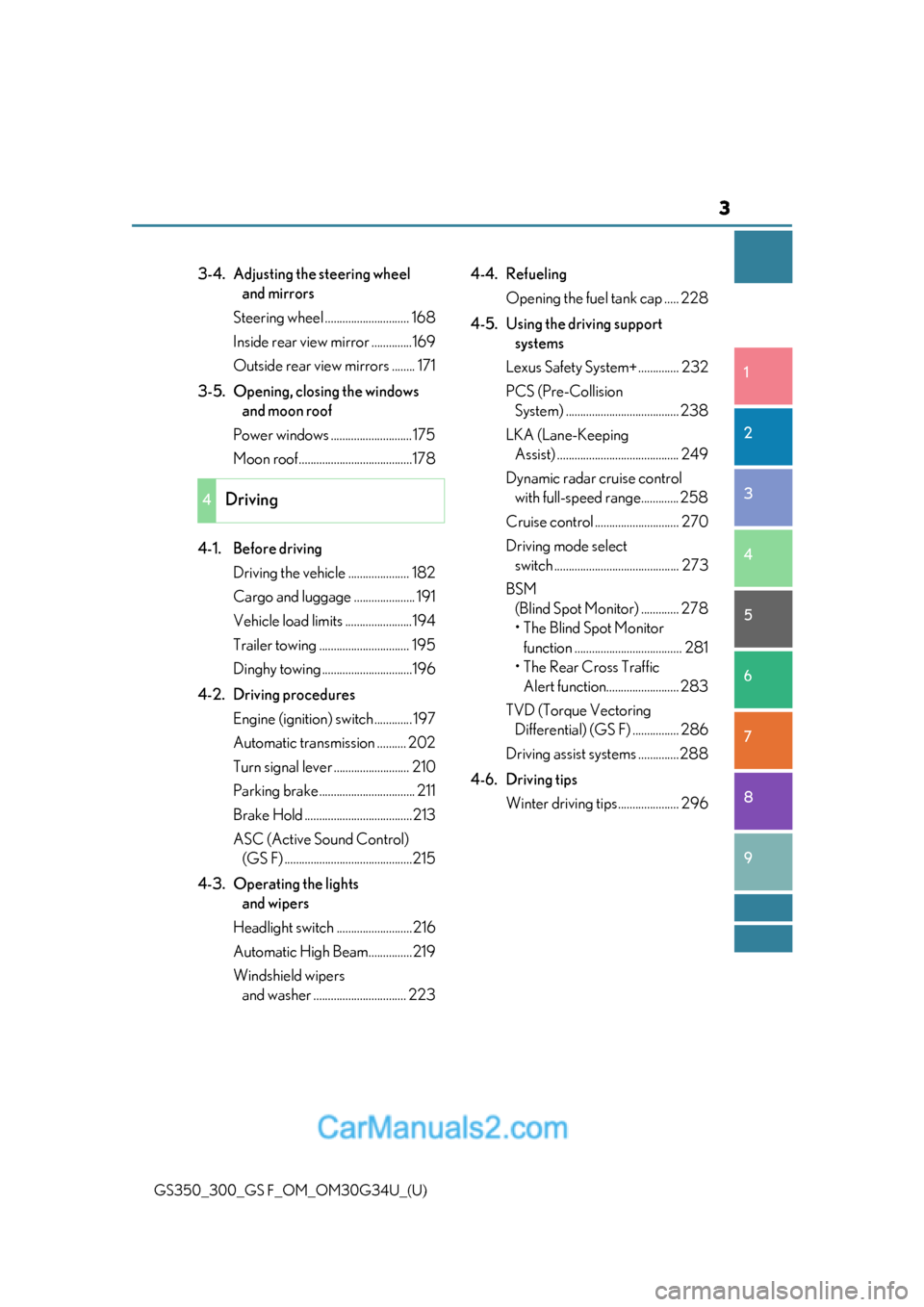
3
1
8 7
6
5
4
3
2
GS350_300_GS F_OM_OM30G34U_(U)
9
3-4. Adjusting the steering wheel and mirrors
Steering wheel ............................. 168
Inside rear view mirror ..............169
Outside rear view mirrors ........ 171
3-5. Opening, closing the windows and moon roof
Power windows ............................175
Moon roof .......................................178
4-1. Before driving Driving the vehicle ..................... 182
Cargo and luggage ..................... 191
Vehicle load limits .......................194
Trailer towing ............................... 195
Dinghy towing ...............................196
4-2. Driving procedures Engine (ign ition) switch ............. 197
Automatic transmission .......... 202
Turn signal lever .......................... 210
Parking brake ................................. 211
Brake Hold .....................................213
ASC (Active Sound Control) (GS F) ............................................215
4-3. Operating the lights and wipers
Headlight switch ..........................216
Automatic High Beam...............219
Windshield wipers and washer ................................ 223 4-4. Refueling
Opening the fuel tank cap ..... 228
4-5. Using the driving support systems
Lexus Safety System+ .............. 232
PCS (Pre-Collision System) ....................................... 238
LKA (Lane-Keeping Assist) .......................................... 249
Dynamic radar cr uise control
with full-speed range............. 258
Cruise control ............................. 270
Driving mode select switch ........................................... 273
BSM (Blind Spot Monitor) ............. 278
• The Blind Spot Monitor
function ..................................... 281
• The Rear Cross Traffic Alert function......................... 283
TVD (Torque Vectoring Differential) (GS F) ................ 286
Driving assist systems ..............288
4-6. Driving tips Winter driving tips..................... 296
4Driving
Page 18 of 602
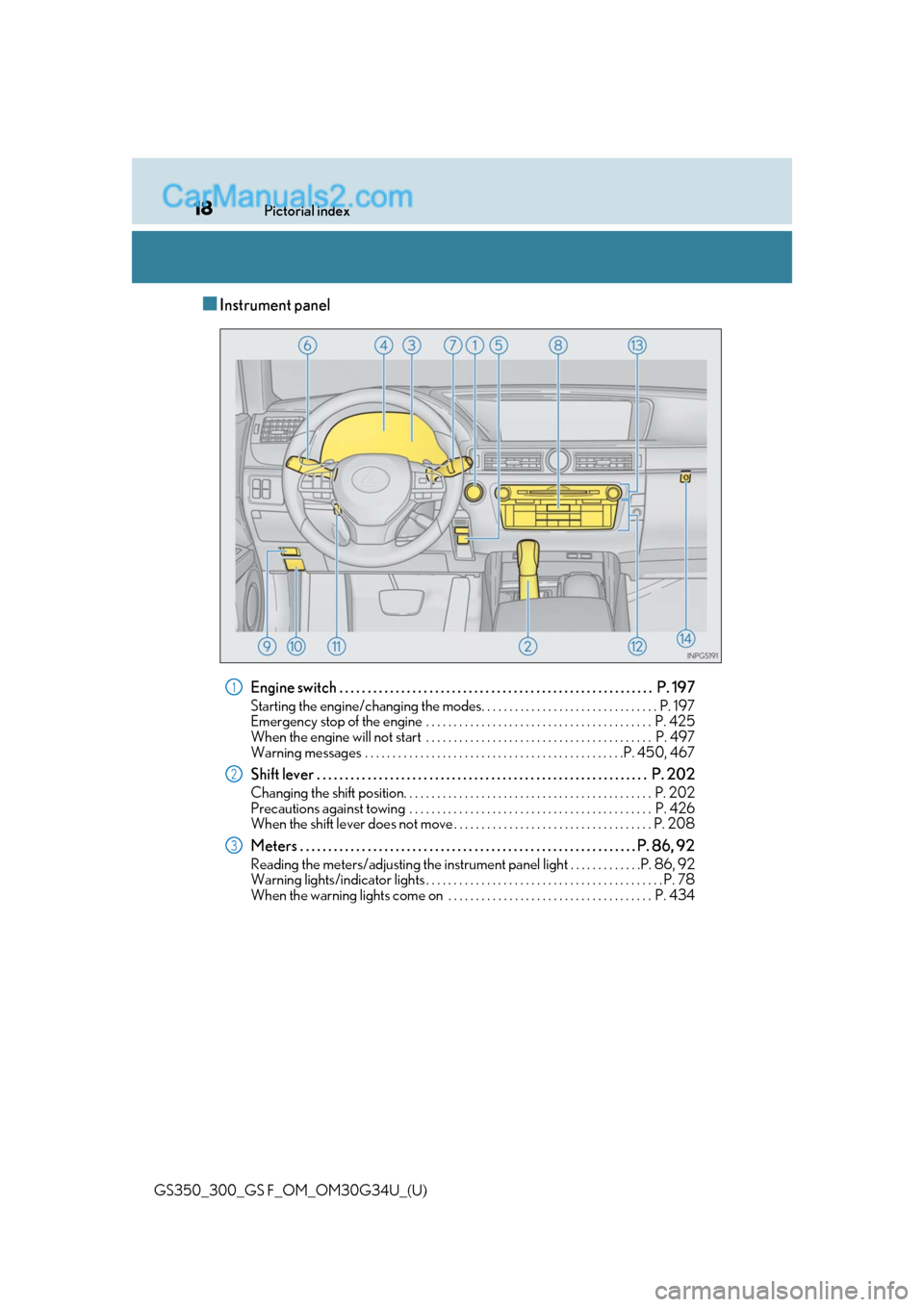
18Pictorial index
GS350_300_GS F_OM_OM30G34U_(U)
■Instrument panel
Engine switch . . . . . . . . . . . . . . . . . . . . . . . . . . . . . . . . . . . . . . . . . . . . . . . . . . . . . . . . P . 197
Starting the engine/changing the modes. . . . . . . . . . . . . . . . . . . . . . . . . . . . . . . . P. 197
Emergency stop of the engine . . . . . . . . . . . . . . . . . . . . . . . . . . . . . . . . . . . . . . . . . P. 425
When the engine will not start . . . . . . . . . . . . . . . . . . . . . . . . . . . . . . . . . . . . . . . . . P. 497
Warning messages . . . . . . . . . . . . . . . . . . . . . . . . . . . . . . . . . . . . . . . . . . . . . . .P. 450, 467
Shift lever . . . . . . . . . . . . . . . . . . . . . . . . . . . . . . . . . . . . . . . . . . . . . . . . . . . . . . . . . . . P. 202
Changing the shift position. . . . . . . . . . . . . . . . . . . . . . . . . . . . . . . . . . . . . . . . . . . . . P. 202
Precautions against towing . . . . . . . . . . . . . . . . . . . . . . . . . . . . . . . . . . . . . . . . . . . . P. 426
When the shift lever does not move . . . . . . . . . . . . . . . . . . . . . . . . . . . . . . . . . . . . P. 208
Meters . . . . . . . . . . . . . . . . . . . . . . . . . . . . . . . . . . . . . . . . . . . . . . . . . . . . . . . . . . . . P . 86, 92
Reading the meters/adjusting the instrument panel light . . . . . . . . . . . . .P. 86, 92
Warning lights/indicator lights . . . . . . . . . . . . . . . . . . . . . . . . . . . . . . . . . . . . . . . . . . . P. 78
When the warning lights come on . . . . . . . . . . . . . . . . . . . . . . . . . . . . . . . . . . . . . P. 434
1
2
3
Page 175 of 602
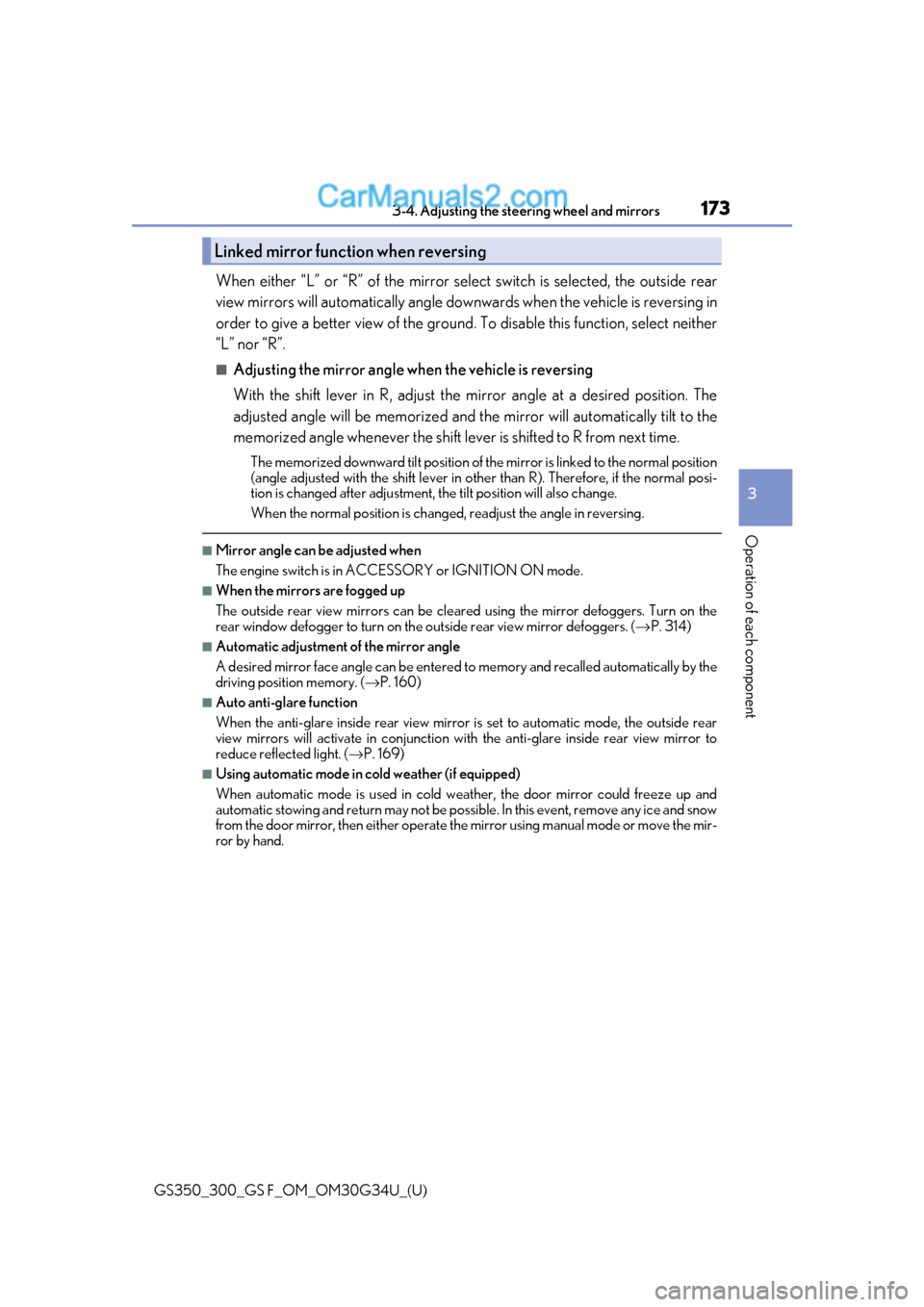
1733-4. Adjusting the steering wheel and mirrors
3
Operation of each component
GS350_300_GS F_OM_OM30G34U_(U)
When either “L” or “R” of the mirror select switch is selected, \
the outside rear
view mirrors will automatically angle downwards when the vehicle is reversing in
order to give a better view of the ground . To disable this function, select neither
“L” nor “R”.
■Adjusting the mirror angle when the vehicle is reversing
With the shift lever in R, adjust the mirror angle at a desired position. The
adjusted angle will be memorized and the mirror will automatically tilt to the
memorized angle whenever the shift leve r is shifted to R from next time.
The memorized downward tilt position of th e mirror is linked to the normal position
(angle adjusted with the shif t lever in other than R). Ther efore, if the normal posi-
tion is changed after adjustment, the tilt position will also change.
When the normal position is chang ed, readjust the angle in reversing.
■Mirror angle can be adjusted when
The engine switch is in ACCESSORY or IGNITION ON mode.
■When the mirrors are fogged up
The outside rear view mirrors can be cleare d using the mirror defoggers. Turn on the
rear window defogger to turn on the outside rear view mirror defoggers. ( →P. 314)
■Automatic adjustment of the mirror angle
A desired mirror face angle can be entered to memory and recalled automatically by the
driving position memory. ( →P. 160)
■Auto anti-glare function
When the anti-glare inside re ar view mirror is set to automatic mode, the outside rear
view mirrors will activate in conjunction with the anti-glare inside rear view mirror to
reduce reflected light. ( →P. 169)
■Using automatic mode in cold weather (if equipped)
When automatic mode is used in cold weather, the door mirror could freeze up and
automatic stowing and return may not be possible. In this event, remove any ice and snow
from the door mirror, then either operate th e mirror using manual mode or move the mir-
ror by hand.
Linked mirror function when reversing
Page 183 of 602
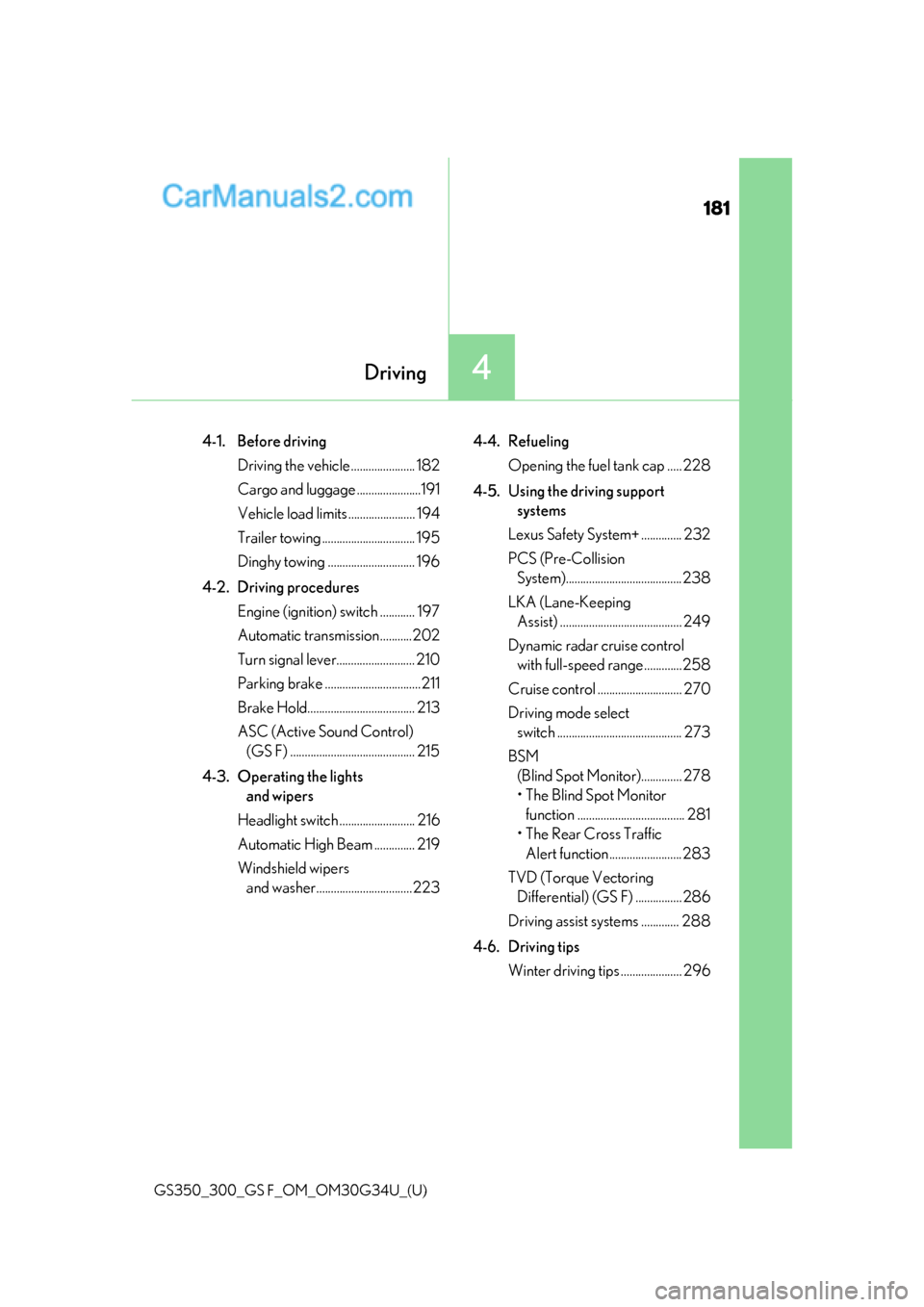
181
GS350_300_GS F_OM_OM30G34U_(U)
4Driving
4-1. Before drivingDriving the vehicle ...................... 182
Cargo and luggage ......................191
Vehicle load limits ....................... 194
Trailer towing ................................ 195
Dinghy towing .............................. 196
4-2. Driving procedures Engine (ignition) switch ............ 197
Automatic transmission...........202
Turn signal lever........................... 210
Parking brake .................................211
Brake Hold..................................... 213
ASC (Active Sound Control) (GS F) ........................................... 215
4-3. Operating the lights and wipers
Headlight switch .......................... 216
Automatic High Beam .............. 219
Windshield wipers and washer.................................223 4-4. Refueling
Opening the fuel tank cap ..... 228
4-5. Using the driving support systems
Lexus Safety System+ .............. 232
PCS (Pre-Collision System)........................................238
LKA (Lane-Keeping Assist) .......................................... 249
Dynamic radar cruise control with full-speed range .............258
Cruise control ............................. 270
Driving mode select switch ........................................... 273
BSM (Blind Spot Moni tor).............. 278
• The Blind Spot Monitor function ..................................... 281
• The Rear Cross Traffic
Alert function .........................283
TVD (Torque Vectoring Differential) (GS F) ................ 286
Driving assist systems ............. 288
4-6. Driving tips Winter driving tips ..................... 296
Page 193 of 602
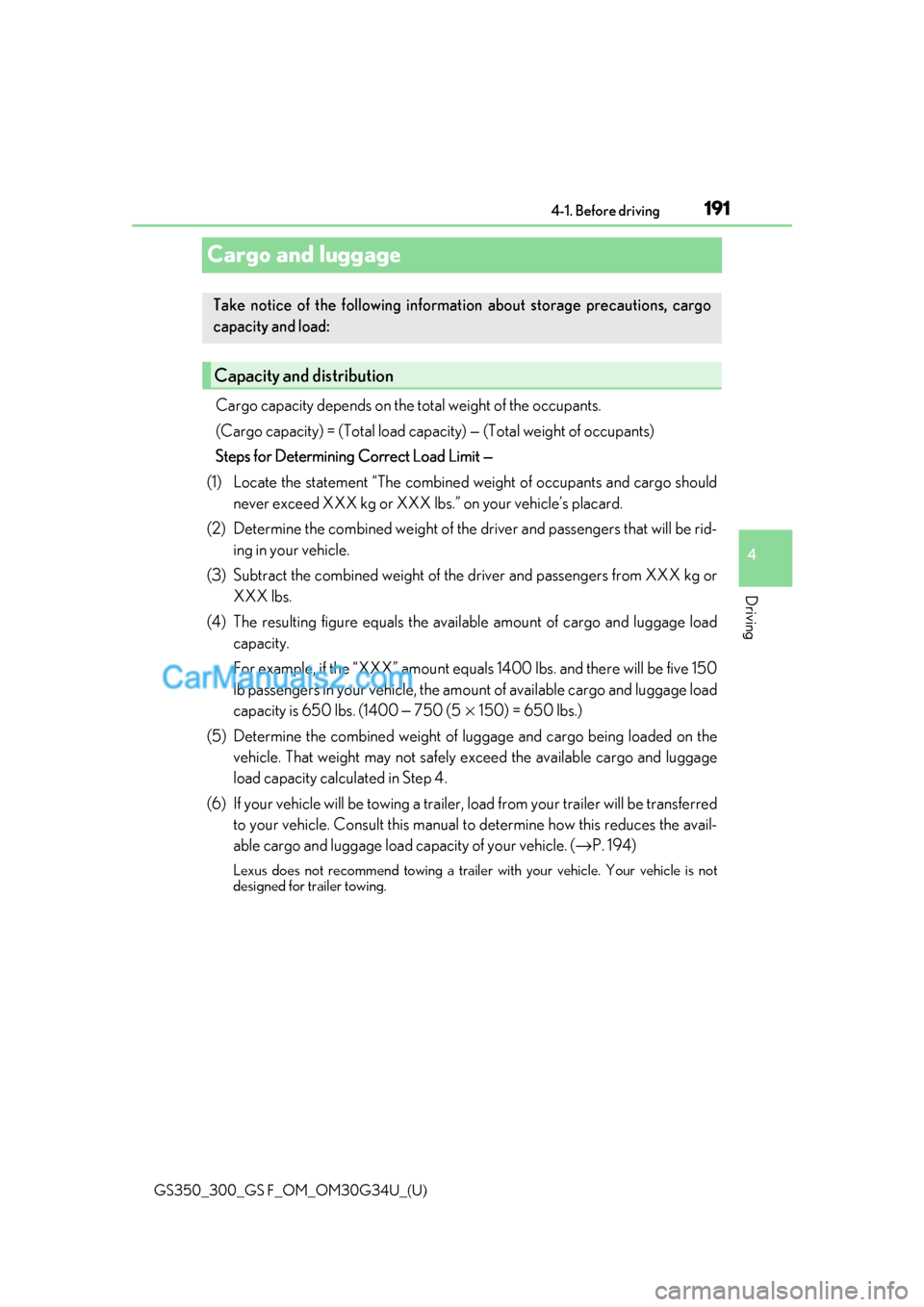
191
GS350_300_GS F_OM_OM30G34U_(U)4-1. Before driving
4
Driving
Cargo and luggage
Cargo capacity depends on the total weight of the occupants.
(Cargo capacity) = (Total load capac
ity) — (Total weight of occupants)
Steps for Determining Correct Load Limit —
(1) Locate the statement “The combined weight of occupants and cargo should
never exceed XXX kg or XXX lbs. ” on your vehicle’s placard.
(2) Determine the combined weight of th e driver and passengers that will be rid-
ing in your vehicle.
(3) Subtract the combined weight of th e driver and passengers from XXX kg or
XXX lbs.
(4) The resulting figure equals the ava ilable amount of cargo and luggage load
capacity.
For example, if the “XXX” amount equals 1400 lbs. and there will be five 150
lb passengers in your vehicle, the amou nt of available cargo and luggage load
capacity is 650 lbs. (1400 − 750 (5 × 150) = 650 lbs.)
(5) Determine the combined weight of luggage and cargo being loaded on the
vehicle. That weight may not safely exceed the available cargo and luggage
load capacity calculated in Step 4.
(6) If your vehicle will be towing a trailer, load from your trailer will be transferred
to your vehicle. Consult this manual to determine how this reduces the avail-
able cargo and luggage load capacity of your vehicle. ( →P. 194)
Lexus does not recommend towing a trailer with your vehicle. Your vehicle is not
designed for trailer towing.
Take notice of the following informat ion about storage precautions, cargo
capacity and load:
Capacity and distribution
Page 196 of 602
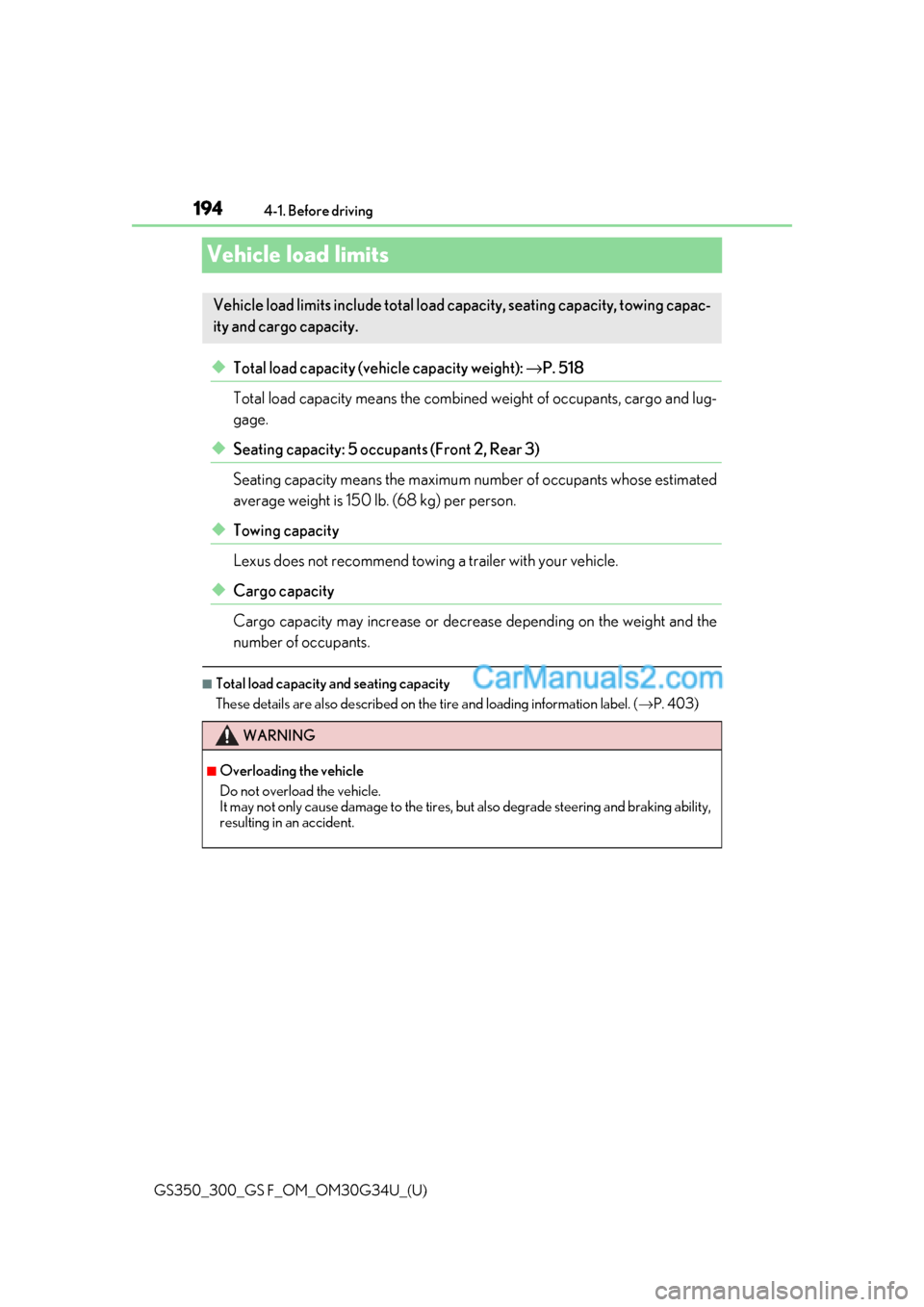
194
GS350_300_GS F_OM_OM30G34U_(U)4-1. Before driving
Vehicle load limits
◆Total load capacity (vehicle capacity weight):
→P. 518
Total load capacity means the combined weight of occupants, cargo and lug-
gage.
◆Seating capacity: 5 occupants (Front 2, Rear 3)
Seating capacity means the maximum number of occupants whose estimated
average weight is 150 lb. (68 kg) per person.
◆Towing capacity
Lexus does not recommend towing a trailer with your vehicle.
◆Cargo capacity
Cargo capacity may increase or decrease depending on the weight and the
number of occupants.
■Total load capacity and seating capacity
These details are also described on the tire and loading information label. (→P. 403)
Vehicle load limits include total load capacity, seating capacity, towing capac-
ity and cargo capacity.
WARNING
■Overloading the vehicle
Do not overload the vehicle.
It may not only cause damage to the tires, but also degrade steering and braking ability,
resulting in an accident.
Page 197 of 602
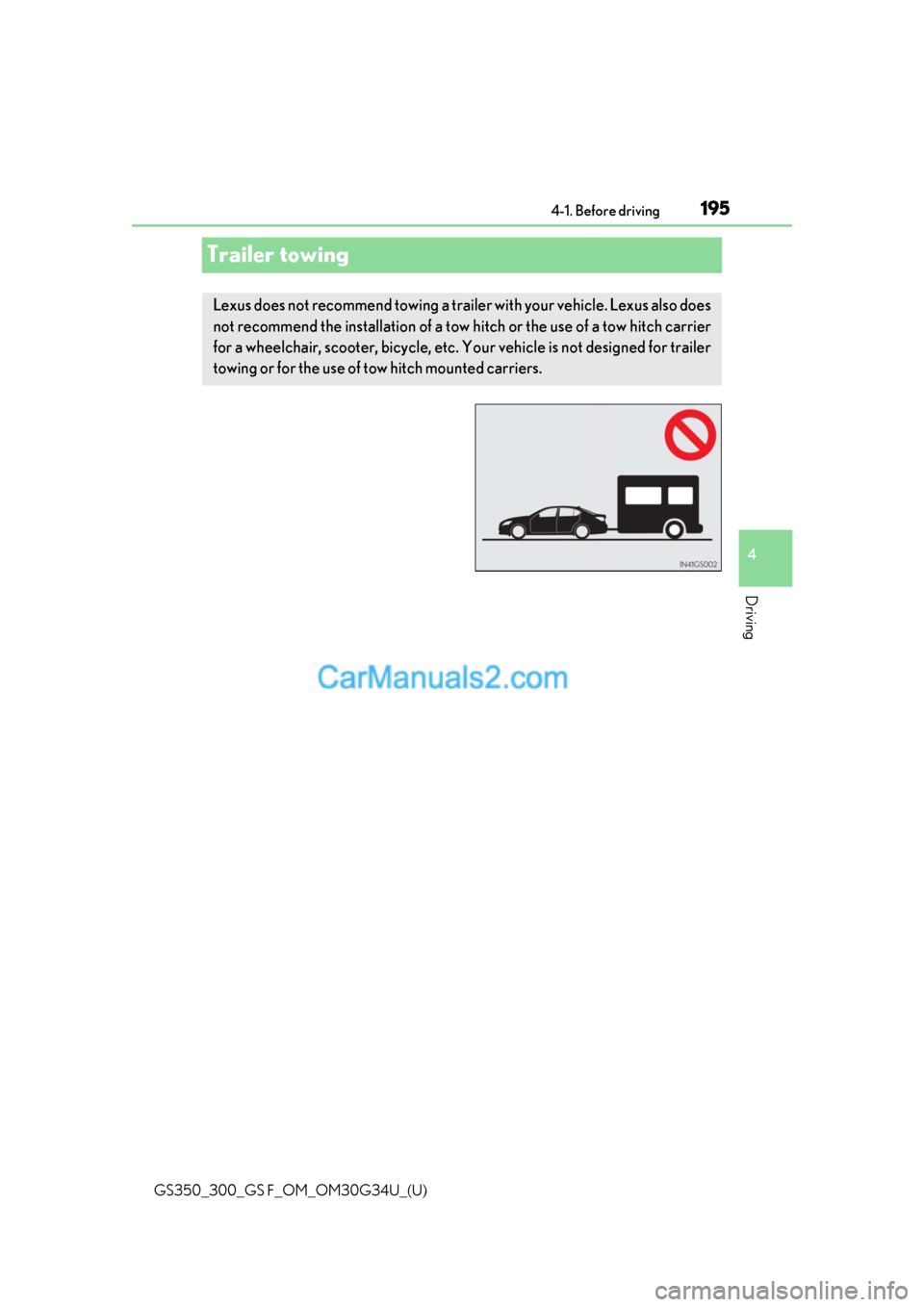
195
GS350_300_GS F_OM_OM30G34U_(U)4-1. Before driving
4
Driving
Trailer towing
Lexus does not recommend towing a trailer with your vehicle. Lexus also does
not recommend the installation of a tow
hitch or the use of a tow hitch carrier
for a wheelchair, scooter, bicycle, etc. Your vehicle is not designed for trailer
towing or for the use of tow hitch mounted carriers.
Page 198 of 602
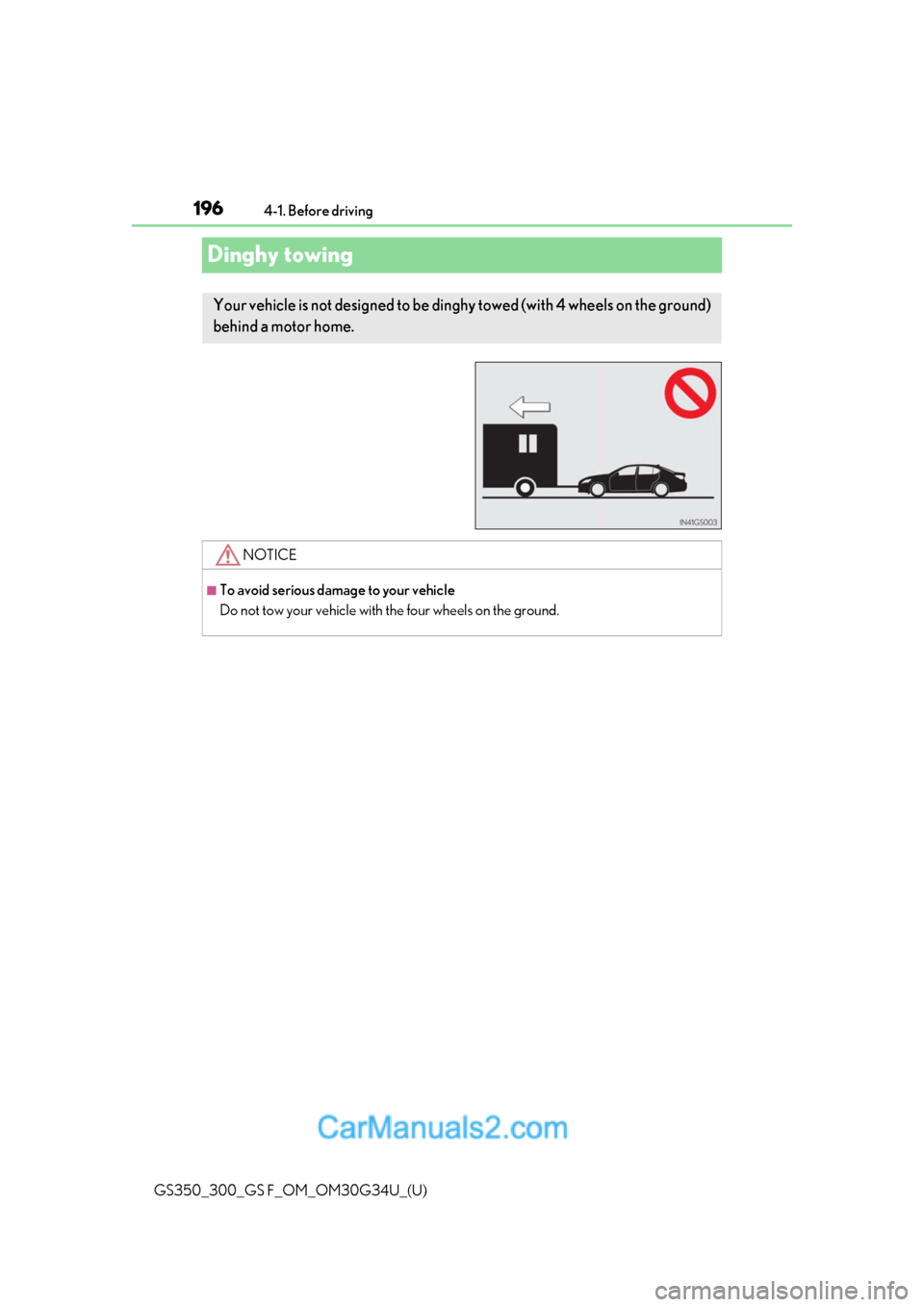
196
GS350_300_GS F_OM_OM30G34U_(U)4-1. Before driving
Dinghy towing
Your vehicle is not designed to be dinghy towed (with 4 wheels on the ground)
behind a motor home.
NOTICE
■To avoid serious damage to your vehicle
Do not tow your vehicle with the four wheels on the ground.
Page 242 of 602
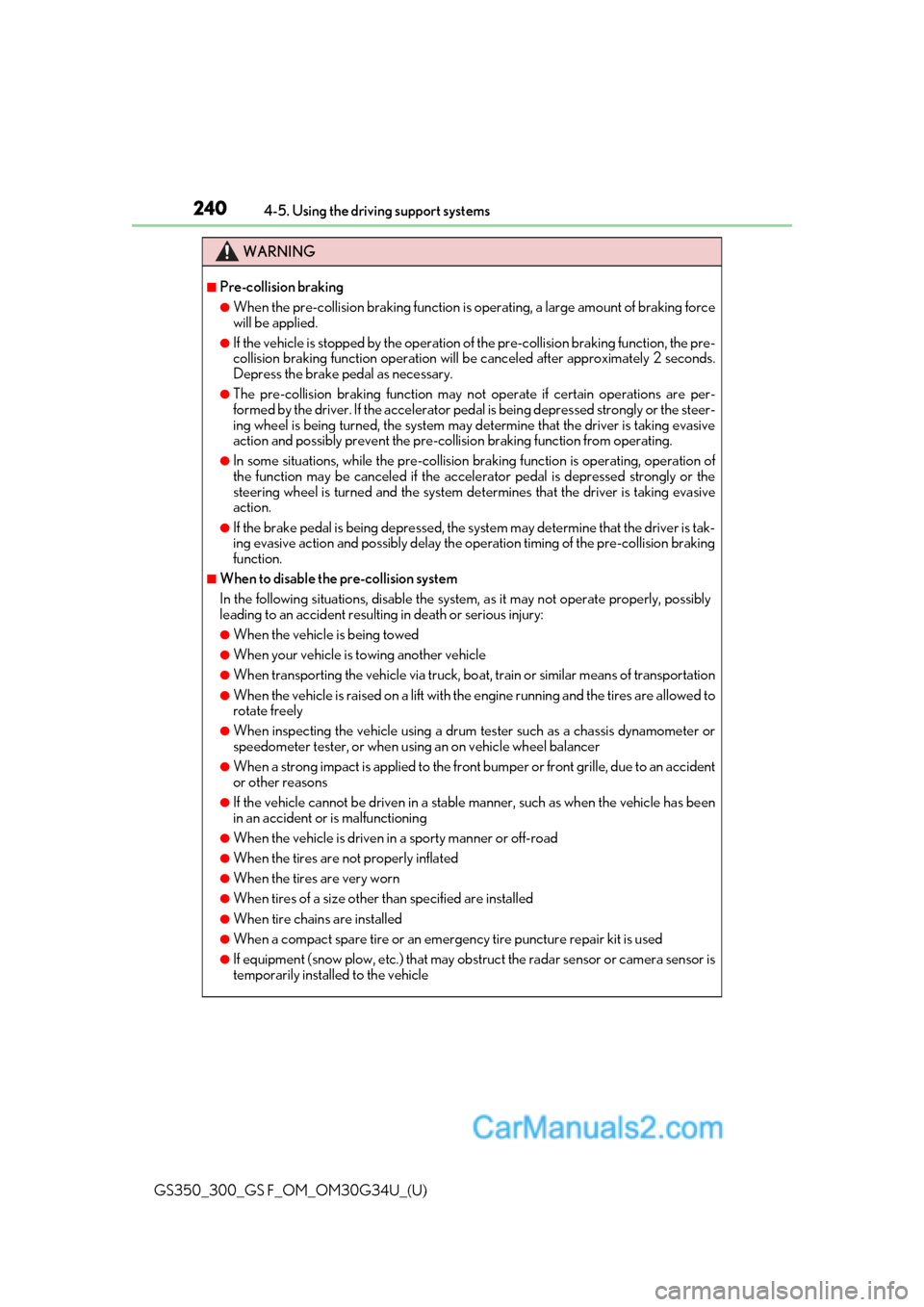
240
GS350_300_GS F_OM_OM30G34U_(U)4-5. Using the driving support systems
WARNING
■Pre-collision braking
●When the pre-collision braking function is
operating, a large amount of braking force
will be applied.
●If the vehicle is stopped by the operation of the pre-collision braking function, the pre-
collision braking function operation will be canceled after approximately 2 seconds.
Depress the brake pedal as necessary.
●The pre-collision braking fu nction may not operate if certain operations are per-
formed by the driver. If the accelerator pedal is being depressed strongly or the steer-
ing wheel is being turned, the system may de termine that the driver is taking evasive
action and possibly prevent the pre-coll ision braking function from operating.
●In some situations, while the pre-collision braking function is operating, operation of
the function may be canceled if the accele rator pedal is depressed strongly or the
steering wheel is turned and the system de termines that the driver is taking evasive
action.
●If the brake pedal is being depressed, the sy stem may determine that the driver is tak-
ing evasive action and possibly delay the op eration timing of the pre-collision braking
function.
■When to disable the pre-collision system
In the following situations, di sable the system, as it may not operate properly, possibly
leading to an accident resultin g in death or serious injury:
●When the vehicle is being towed
●When your vehicle is towing another vehicle
●When transporting the vehicle via truck, bo at, train or similar means of transportation
●When the vehicle is raised on a lift with the engine running and the tires are allowed to
rotate freely
●When inspecting the vehicle using a drum tester such as a chassis dynamometer or
speedometer tester, or when using an on vehicle wheel balancer
●When a strong impact is applied to the fron t bumper or front grille, due to an accident
or other reasons
●If the vehicle cannot be driven in a stable manner, such as when the vehicle has been
in an accident or is malfunctioning
●When the vehicle is driven in a sporty manner or off-road
●When the tires are not properly inflated
●When the tires are very worn
●When tires of a size other than specified are installed
●When tire chains are installed
●When a compact spare tire or an emergency tire puncture repair kit is used
●If equipment (snow plow, etc.) that may obstruct the radar sensor or camera sensor is
temporarily installed to the vehicle
Page 262 of 602
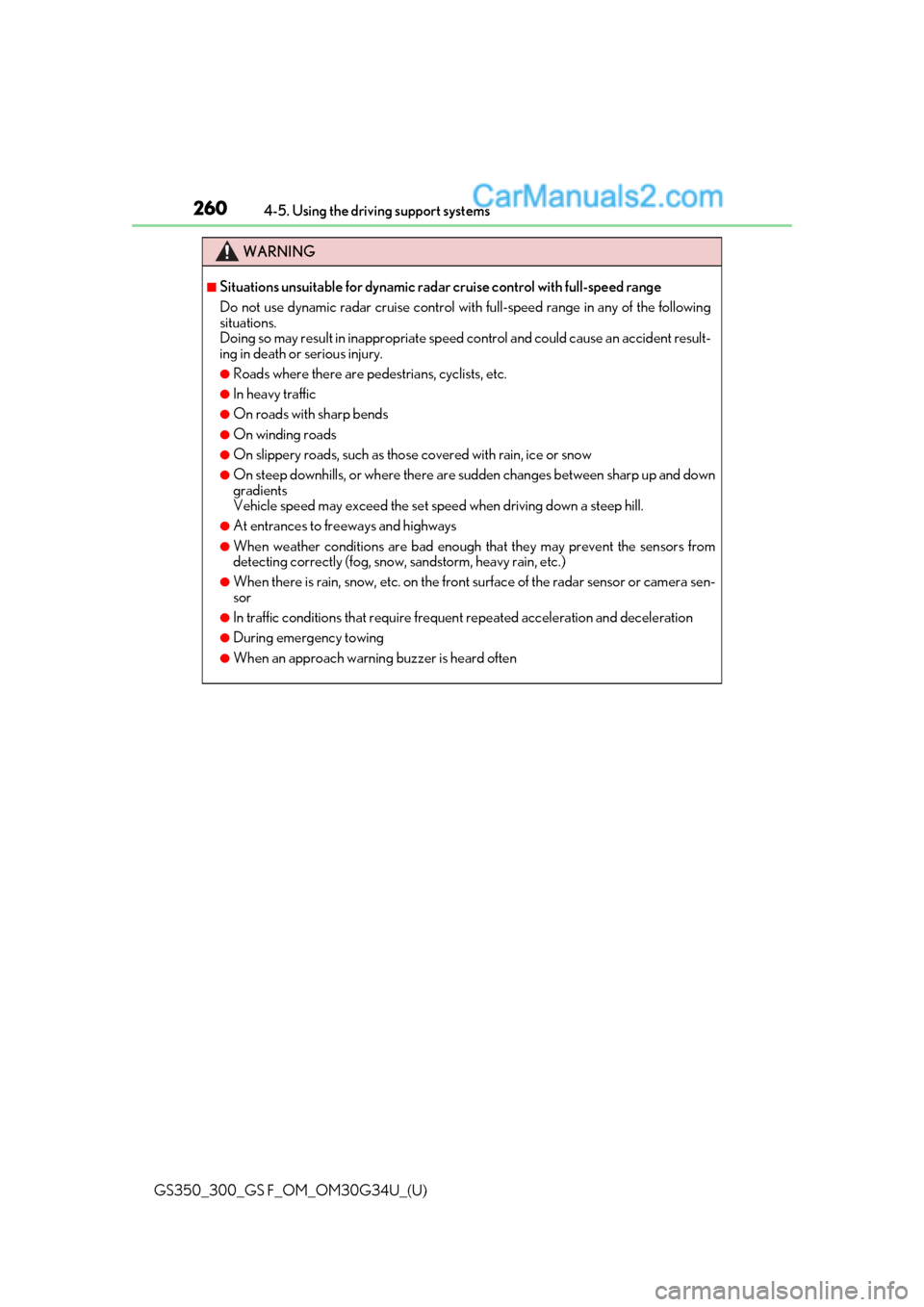
260
GS350_300_GS F_OM_OM30G34U_(U)4-5. Using the driving support systems
WARNING
■Situations unsuitable for dynamic rada
r cruise control with full-speed range
Do not use dynamic radar cruise control with full-speed range in any of the following
situations.
Doing so may result in inappropriate speed control and could cause an accident result-
ing in death or serious injury.
●Roads where there are pede strians, cyclists, etc.
●In heavy traffic
●On roads with sharp bends
●On winding roads
●On slippery roads, such as thos e covered with rain, ice or snow
●On steep downhills, or where there are sudden changes between sharp up and down
gradients
Vehicle speed may exceed the set speed when driving down a steep hill.
●At entrances to freeways and highways
●When weather conditions are bad enough that they may prevent the sensors from
detecting correctly (fog, snow, sandstorm, heavy rain, etc.)
●When there is rain, snow, etc. on the fron t surface of the radar sensor or camera sen-
sor
●In traffic conditions that require frequent repeated a cceleration and deceleration
●During emergency towing
●When an approach warning buzzer is heard often